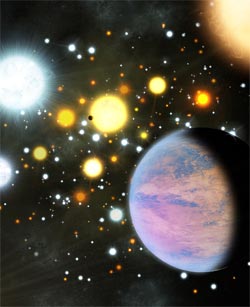First Transiting Planets in a Star Cluster Discovered

In the star cluster NGC 6811, astronomers have found two planets smaller than Neptune orbiting Sun-like stars. Credit: Michael Bachofner<br>
Others form in huge, dense swarms that survive for billions of years as stellar clusters. Within such rich and dense clusters, stars jostle for room with thousands of neighbors while strong radiation and harsh stellar winds scour interstellar space, stripping planet-forming materials from nearby stars.
It would thus seem an unlikely place to find alien worlds. Yet 3,000 light-years from Earth, in the star cluster NGC 6811, astronomers have found two planets smaller than Neptune orbiting Sun-like stars. The discovery, published in the journal Nature, shows that planets can develop even in crowded clusters jam-packed with stars.
“Old clusters represent a stellar environment much different than the birthplace of the Sun and other planet-hosting field stars,” says lead author Soren Meibom of the Harvard-Smithsonian Center for Astrophysics (CfA). “And we thought maybe planets couldn't easily form and survive in the stressful environments of dense clusters, in part because for a long time we couldn't find them.”
The two new alien worlds appeared in data from NASA's Kepler spacecraft. Kepler hunts for planets that transit, or cross in front of, their host stars. During a transit, the star dims by an amount that depends on the size of the planet, allowing the size to be determined. Kepler-66b and Kepler-67b are both less than three times the size of Earth, or about three-fourths the size of Neptune (mini-Neptunes).
Of the more than 850 known planets beyond our solar system, only four – all similar to or greater than Jupiter in mass – were found in clusters. Kepler-66b and -67b are the smallest planets to be found in a star cluster, and the first cluster planets seen to transit their host stars, which enables the measurement of their sizes.
Meibom and his colleagues have measured the age of NGC 6811 to be one billion years. Kepler-66b and Kepler-67b therefore join a small group of planets with precisely determined ages, distances, and sizes.
Considering the number of stars observed by Kepler in NGC 6811, the detection of two such planets implies that the frequency and properties of planets in open clusters are consistent with those of planets around field stars (stars not within a cluster or association) in the Milky Way galaxy.
“These planets are cosmic extremophiles,” says Meibom. “Finding them shows that small planets can form and survive for at least a billion years, even in a chaotic and hostile environment.”
Headquartered in Cambridge, Mass., the Harvard-Smithsonian Center for Astrophysics (CfA) is a joint collaboration between the Smithsonian Astrophysical Observatory and the Harvard College Observatory. CfA scientists, organized into six research divisions, study the origin, evolution and ultimate fate of the universe.
For more information, contact:
Soren Meibom
Astronomer
smeibom@cfa.harvard.edu
smeibom@gmail.com
David A. Aguilar
Director of Public Affairs
Harvard-Smithsonian Center for Astrophysics
617-495-7462
daguilar@cfa.harvard.edu
Christine Pulliam
Public Affairs Specialist
Harvard-Smithsonian Center for Astrophysics
617-495-7463
cpulliam@cfa.harvard.edu
Media Contact
More Information:
http://www.cfa.harvard.eduAll latest news from the category: Physics and Astronomy
This area deals with the fundamental laws and building blocks of nature and how they interact, the properties and the behavior of matter, and research into space and time and their structures.
innovations-report provides in-depth reports and articles on subjects such as astrophysics, laser technologies, nuclear, quantum, particle and solid-state physics, nanotechnologies, planetary research and findings (Mars, Venus) and developments related to the Hubble Telescope.
Newest articles

Security vulnerability in browser interface
… allows computer access via graphics card. Researchers at Graz University of Technology were successful with three different side-channel attacks on graphics cards via the WebGPU browser interface. The attacks…

A closer look at mechanochemistry
Ferdi Schüth and his team at the Max Planck Institut für Kohlenforschung in Mülheim/Germany have been studying the phenomena of mechanochemistry for several years. But what actually happens at the…

Severe Vulnerabilities Discovered in Software to Protect Internet Routing
A research team from the National Research Center for Applied Cybersecurity ATHENE led by Prof. Dr. Haya Schulmann has uncovered 18 vulnerabilities in crucial software components of Resource Public Key…





















